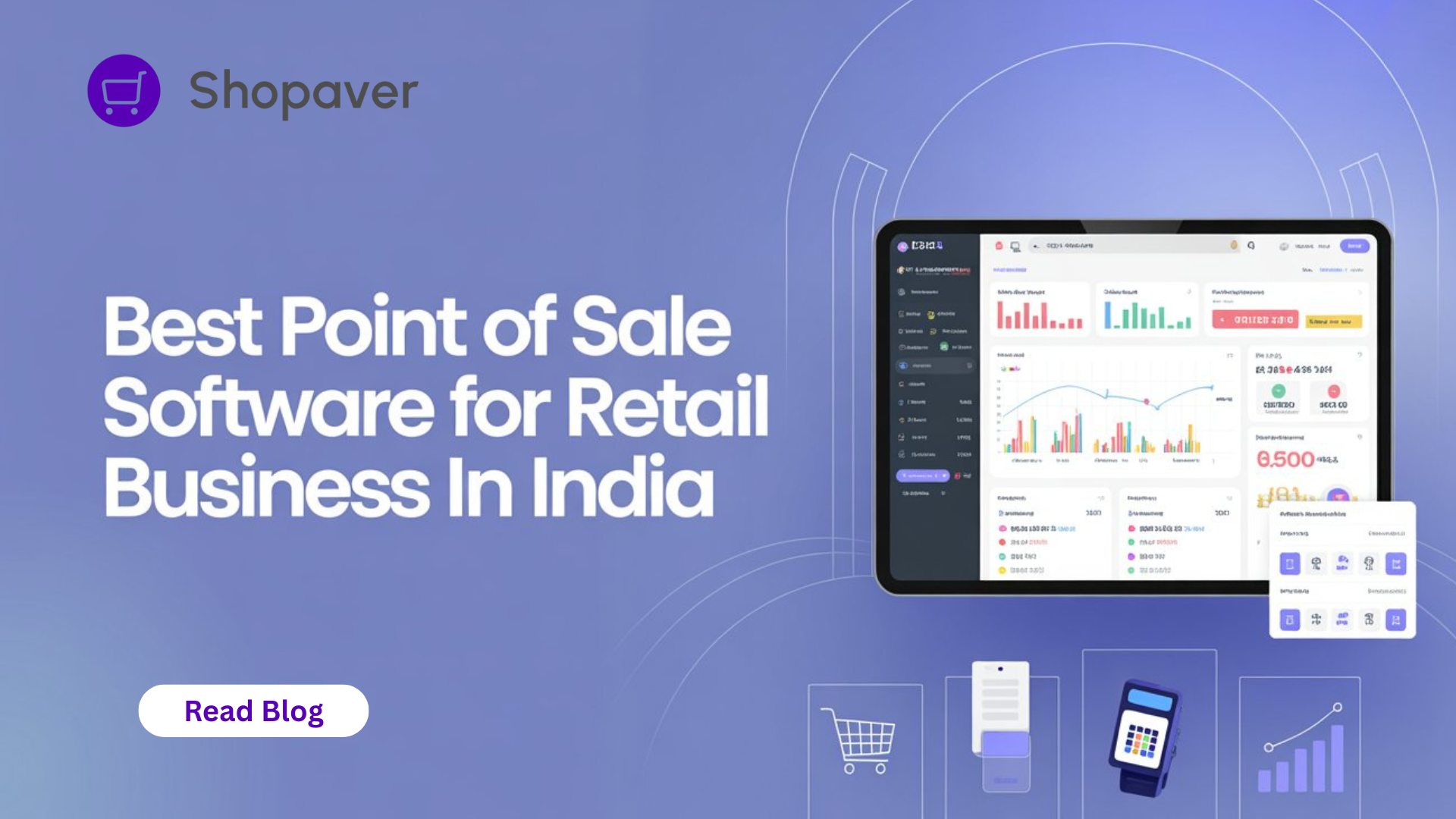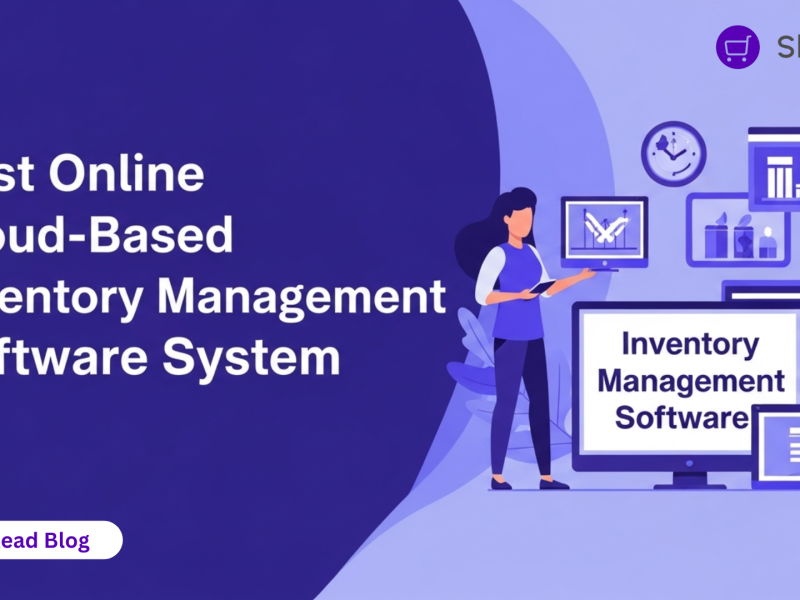Running a retail store in India today is far more complex than just billing a customer. From handling barcodes and scanning to multiple payment modes (UPI, wallets, cards), to GST-compliance, stock tracking, expiry management, and now even online-offline integration, modern retail demands a smart Point of Sale (POS) system. If you aim to stay competitive, efficient and scalable, choosing the right POS is essential.
- What POS software is.
- Why retail businesses (especially in India) must upgrade.
- Key features to look for.
- Common mistakes in selection.
- Why Shopaver is an excellent choice for Indian retailers.
- A quick guide to rollout.
1. What is Point of Sale (POS) software?
A POS system is the software (and often hardware) at the checkout counter where sales are recorded. But in today’s world, it’s much more than tallying transactions.
It handles billing, discounts, multiple payment modes, customer receipts, returns, and often links with inventory, reporting, tax compliance and even online sales channels.
In other words: the POS is the nerve-centre of a retail store — where customers, stock and payments converge. If this centre is slow or disconnected, the business loses time, accuracy and margin.
2. Why retail stores in India (small & medium) must upgrade their POS
In many traditional shops you’ll see: manual billing, hand-written receipts, separate spreadsheets for stock, little digital reconciliation. These cause real problems:
- Longer queues, frustrated customers.
- Stockouts of popular items, and overstock of slow-moving items.
- Mistakes in discounting, wrong pricing, lost margin.
- Complexity in GST billing, returns and compliances.
- No visibility into what sells, when and in which store (if multi-outlet).
Upgrading to a modern POS solves all that. It speeds checkout, reduces errors, gives you real-time stock visibility, supports digital payments and ensures you spend less time on paperwork and more time selling.
From Shopaver’s blog: “For small businesses… managing day-to-day operations manually can cause mistakes and waste valuable time.”
And: “Long queues at the counter? Slow billing? Confused inventory? That’s where a retail POS comes in.”
3. Key features to look for in the best POS system for retail
When you evaluate a POS for your retail business, especially in India, make sure you check for these features:
1. Easy Billing & Checkout
- Barcode scanning, quick item lookup
- Fast UI so staff don’t waste time
- Support for discounts, bundles, variants
- Split payments (cash + UPI + card)
2. Inventory Management Integration
- Real-time stock reduction at checkout
- Alerts for low stock / out of stock
- Batch / expiry tracking (important for groceries, pharmacy)
- Multi-store stock transfers if you have more than one outlet
3. Multi-Payment Options
India is digital: UPI, wallets, card payments, cash — your POS must support all. From Shopaver blog: “The software should allow quick and simple billing. Features like barcode scanning help make checkout faster… Multi-payment options make it easier for your customers to pay their way.”
4. GST & Indian Compliance
Your POS must generate GST-compliant invoices, support HSN/SAC codes, maintain records for returns and tax filings. Without this you expose your business to risk.
5. Reports & Analytics
Beyond daily billing, you should get insight: which SKUs sell fastest, which counters are slower, sales by payment mode, margin per category. This arms you to act rather than just react.
6. Cloud & Mobility / Offline Mode
- Cloud access means you (owner) can check from anywhere.
- Offline mode means billings don’t stop when internet is bad (a frequent Indian scenario).
- Mobile/Tablet friendly helps for pop-up shops, kiosks or remote counters.
7. Ease of Use & Local Support
For small retail shops, staff turnover is high and training time should be minimal. A simple UI + local support (Hindi/regional language) helps enormously.
8. Affordable & Scalable
The POS must fit your budget now and grow with you (multiple counters, more SKUs, multi-outlet). No huge upfront cost and no hidden fees.
4. Common mistakes when choosing POS
Many retailers make avoidable mistakes when picking a POS. These include:
- Choosing software that is too complex, with lots of features you won’t use, which slows down staff.
- Ignoring whether it supports GST / Indian tax rules properly.
- Forgetting to check offline mode (internet outages are real).
- Failing to check payment mode support (UPI, wallets) and hardware options (barcode, QR).
- Not considering inventory management integration — you might get a “billing only” system which doesn’t help you with stock.
- Not verifying cost and scalability: some systems cost low now but have big costs when you add counters or stores.
- Not training staff or migrating data properly — the best software fails if you implement it badly.
5. Why Shopaver is a smart choice for Indian retail businesses
Now let’s look at why Shopaver stands out as an excellent POS & retail software for India-based retail and small/medium businesses.
1. Designed for Indian retail context
Shopaver understands the local demands — GST billing, multiple payment modes, offline patches, real-time stock alerts. The blog says: “When it comes to selecting the best POS system for small retail businesses in India, Shopaver stands out for its user-friendly interface, fast billing capabilities, and integrated inventory management.”
2. Built-in inventory, billing and reporting
Unlike generic POS systems which only bill, Shopaver links billing, inventory and analytics. From the blog: “Shopaver provides real-time inventory management with advanced features… Auto stock updates with every sale… Low-stock and out-of-stock alerts…”
3. Multi-payment & checkout speed
Shopaver supports UPI, cards, wallets, split payments — critical to match today’s Indian customer expectations. It emphasises fast checkout, reducing queue time and improving customer satisfaction.
4. Analytics & decision-making tools
Shopaver’s Dashboard offers modules: recent transactions, top products, low-stock alerts, and custom date-range analytics for seasonal insights. This helps you not just operate, but grow.
5. Affordable & scalable for small retailers
For a small shop, you might not want an expensive enterprise system. Shopaver focuses on small and growing retailers, offering an easy setup and local support. The blog states: “Even small shops can run like professional stores with a good POS.”
6. Local support matters
Having a system built for India means better localisation (languages, payments, tax) and faster support. That is a big plus compared to global generic systems.
6. Quick guide to implementing your POS efficiently
To get the maximum value from your POS roll-out, follow this simple checklist:
- Step 1: Clean up your data. Before migrating, ensure your product list, categories, prices, HSN/SAC codes are accurate.
- Step 2: Define your checkout workflow. Map whether you need one counter, two counters, tablet mobile checkout, etc.
- Step 3: Hardware & Payments. Ensure barcode scanners, QR/UPI readers, card swipe machines are compatible.
- Step 4: Staff training. Spend 1–2 hours with staff walking through billing, returns, discounts, and reconciliation.
- Step 5: Run parallel for a day. For critical days (weekend/festive) run both old and new process to ensure nothing breaks.
- Step 6: Monitor key metrics. After week 1 & week 4 check queue times, error rate in bills, stockouts, top selling items.
- Step 7: Use reports to act. Use analytics: 10% of your SKUs generate 70% of your sales — focus promos there. Make use of low-stock alerts to reorder.
- Step 8: Scale when ready. Add second counter, online store integration or extra outlet when the system is stable and delivering benefits.
In an era where customers expect fast checkout, multiple payment choices and seamless service, and where behind the scenes you must track stock, run promotions, manage GST and analyse data, a robust POS system isn’t optional. It’s essential.
Choosing the right system means you transform your retail operation from reactive to proactive: less time wasted on billing headaches, fewer stock errors, more satisfied customers, and more informed decisions.
For Indian retailers, from small kirana shops to growing multi-outlet chains, the right combination of billing, inventory, and analytics is achieved by a system that understands the local environment. Shopaver is that system, built for India, designed for retail, and tuned to help you grow.



